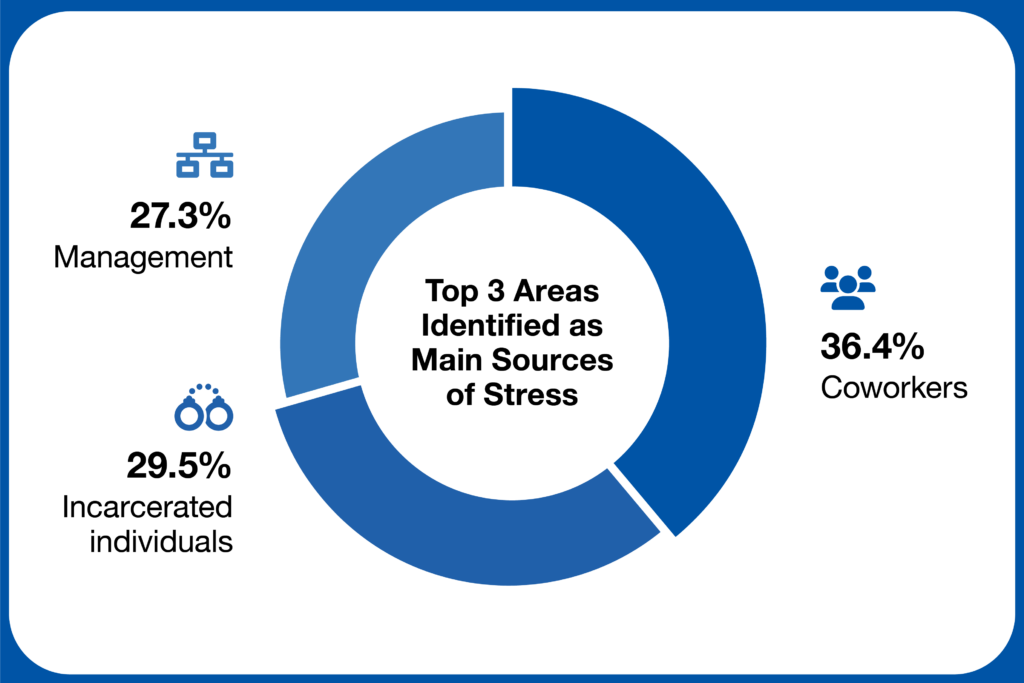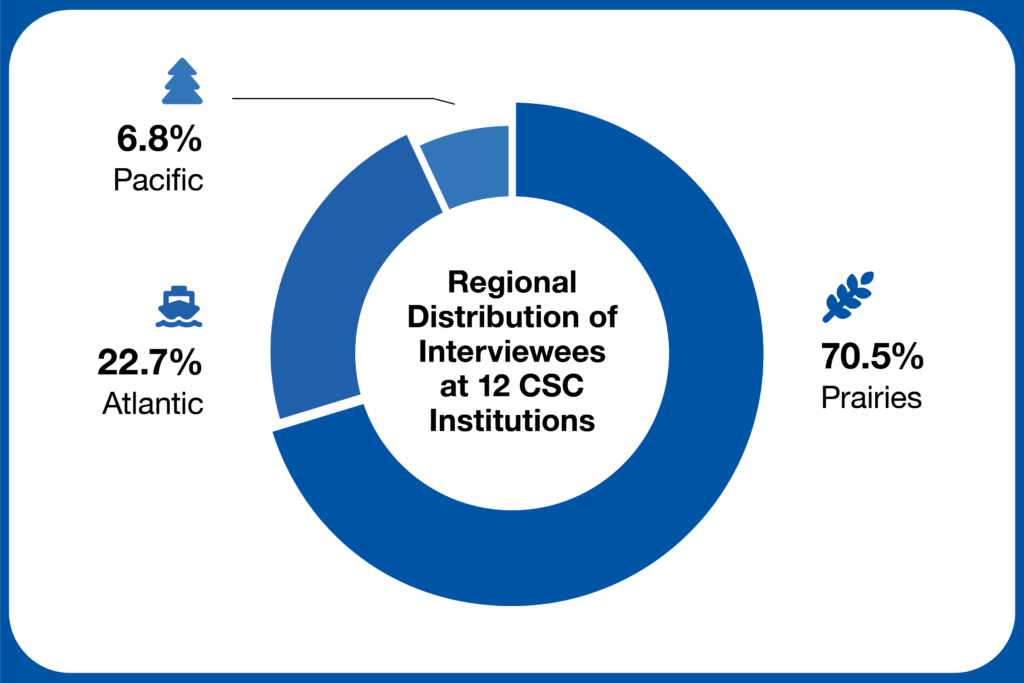
Background
"The literature on stress in correctional work is vast, primarily quantitative, and mostly based on studies conducted in the United States."
Past studies on correctional officers have demonstrated that stress levels identified by those in this line of work are typically high due their "continued exposure to suffering, harm, and violence." These high-stress scenarios may come in the form of witnessing violent events, being victimized by incarcerated individuals, or navigating a "toxic workplace" environment due to staff tensions. Studies have also shown that exposure to these stressors can lead to "mental health injuries such as generalized anxiety disorder and posttraumatic stress disorder."
Three types of stressor identified in prior research can be defined as:
- Job-related stress;
- Stress related to organizational structure; and
- Correctional officer characteristics.
Job-Related Stress
Prior studies have identified two types of common job-related stress among correctional officers: 1) workload issues and 2) role conflicts. Boredom was found to be the most consistently identified as the most typical type of workload issue.
Role conflicts most often emerge as a stress factor for correctional officers who struggle to "reconcile their role as providers of care, control, and custody." Scholars have also examined the stress of "'role ambiguity' (i.e., uncertainty about which tasks and responsibilities)" as being a common feature of stress related to role conflicts; however, in recent research, this is more often identified as a stress that is related to organizational structure.
Stress Related to Organizational Structure
This area of stress most often corresponds to correctional officers' perceptions of being cared for by the institution for which they work. Organizational stressors are most often identified as "decision-making, instrumental communication, organizational justice, leadership quality, and social support." Prior research has identified that a "manager’s ability to support and communicate with team members" and "lack of participation in decision-making" are correlated to stress levels for correctional workers.
Ineffective leadership examples that have been shown to cause stress include:
- Using an overly strict supervisory style;
- Inconsistent or lack of instructions for expected duties;
- Unsupportive or unfair management practices.
In the same way that leadership approaches can create stress, they also have the potential to be a protective factor. For example, some studies have demonstrated that correctionl officers who perceive managers as supportive are less likely to experience stress related to "the risk effect (i.e., potential threat) posed by residents."
"However, management support alone is insufficient for maintaining a healthy work environment in correctional institutions; peer support, including loyalty and collegiality, also matters." Examples of negative peer-to-peer interactions that can cause stress among correctional officers include:
- Unfriendly or hostile interactions among coworkers; and
- Weak or inconsistent staff support (i.e., feeling like your coworkers can't or won't work to maintain safety).
Correctional Officer Characteristics
Although the personality, demographic, and individual characteristics of correctional officers has been studied in relation to stress, no characteristic has been identified to provide a statistically significant impact.
Purpose
Prior research conducted to evaluate correctional officer stress has used quantitative measures. The lack of qualitative data means that former studies may have missed "the opportunity to explore the intricacies and nuances of [correctional officers'] perceptions of stress."
This study focused on correctional officers from "12 federal prisons in Canada." The primary goal was to provide "a qualitative analysis of the topic, which explores the reasons underpinning stress."
Design
Researchers used interviews from 44 correctional officers collected as part of the longitudinal study led by CCWORK. "CCWORK participants work at federal correctional facilities housing about 12,300 men and women sentenced to 2 or more years in custody." The interviews collected by CCWORK range from 45 to 90 minutes in length, and are transcribed from a recording of the phone call or in-person conversation.
These 44 interviews represent a subsample from an original cohort comprised of 118 correctional officer recruits who would be going to "43 correctional institutions in all 5 regions (i.e., Atlantic, Quebec, Ontario, Prairie, and Pacific)" served by Correctional Service Canada (CSC).
"To capture participants’ experiences and perceptions of stress, the interview team first asked participants the following question: 'Where do you think most of your stresses come from?' Then, if necessary, the team probed about whether stress came from residents, colleagues, management, or the public (e.g., media coverage)."
Interviewers were allowed to ask follow-up questions based on initial responses. For example, "when participants indicated staff (i.e., colleagues or managers) as their primary source of stress, the interview team followed up by asking why participants did not consider residents stressful." They were also encouraged to explore "comparisons between different stressors, which could reveal further information on stress dynamics."

The interviews were analyzed using a four-step process, and the 44 interviews represented individuals placed at 12 of CSC's institutions among 3 regions, which were "Prairies (70.5%), Atlantic (22.7%), and Pacific (6.8%)." Other identifying factors were as follows:
- Approximately one third of participants were correctional officers in maximum security facilities, with the remaining two thirds coming from medium- or minimum-security facilities, as well as correctional psychiatric centers.
- A majority of the participants worked in men's institutions and self-identified as male.
- Half of the participants were married.
- Most had earned a postsecondary degree, and roughly one third had earned a university degree.
- Over three quarters had never worked in corrections before.
Findings
The top three areas identified in the interviews were "co-workers (36.4%), residents (29.5%), and management (27.3%) as their main sources of stress."
"Co-worker stress was associated with gossip and seniority. Management stress was connected to power centralization, communication issues, and unsupportive management. Resident stress was linked to uncertainty and unpredictability, residents’ demands amid short staffing, and role conflict."
Examples among each of those three areas included:
- A culture of back-stabbing that required vigilance;
- Being isolated and/or left out due to being placed in a "static post;"
- Downtime or periods of idleness that led to boredom;
- Feeling the need to participate in gossip in order to protect from being ostracized or targeted;
- Feeling their efforts "were in vain;"
- Fearing no one would help if they were attacked by a resident;
- Senior officers imposing "their work practices upon newer officers, regardless of if those practices complied with training, policies, and protocols;"
- Feeling a need to "prove their worthiness" to senior officers in order to gain respect;
- Having to carry out orders that were considered unsafe or incorrect by the correctional officer;
- Being made to carry out "unfeasible policies and protocols;"
- Arbitrary rules put forth by management that create inconsistencies and undermine correctional officers' authority;
- Superiors being unconcerned with officers' thoughts, needs, or concerns;
- "Lack of instrumental communication in carrying out tasks and meeting expectations;"
- Being moved around within the institutions too frequently, creating an inability to establish consistency with incarcerated individuals and being more prone to manipulation;"
- Not knowing the resident populations well enough to prevent violence between groups;
- Unsupportive management with a lack of "accountability, reliability, and fairness;"
- Feeling distrusted by management when supervised with "intense oversight;"
- The "uncertainty and unpredictability" of incarcerated individuals;
- Being expected to "handle" incarcerated individuals;
- Short staffing at facilities and high turnover rates among correctional officers;
- "Balancing care and custody" when dealing with incarcerated individuals.
Conclusion
Final analysis "indicated staff as a significant source of stress in correctional work," with gossip and seniority being the two most consistently identified factors for co-worker related stress. The connection between gossip and boredom might warrant further study.
In addition, "findings about using seniority to acculturate new hires raise questions about how and to what extent hierarchy and chain of command." The practice of asking correctional officers to blindly obey hierarchical structures - as opposed to their training or established protocols - "in a closed and coercive environment like corrections may open the door to resident and staff abuse and thus compromise the legitimacy of a correctional system."
"Overall, findings corroborated existing studies presenting centralization as a stress correlate." The authoritarian structure that often results from power centralization "can compromise organizational justice." It can also lead to the implementation of unrealistic policies and a punitive culture that de-motivates correctional officers. "Lack of effective communication was another stress trigger linked to management."
Future research recommended by the authors included: 1) exploring the reasons and social dynamics related to co-workers being identified as a source of stress; and 2) "the paramilitary nature of correctional services and its intended and unintended consequences on correctional work."
* References available upon request.

